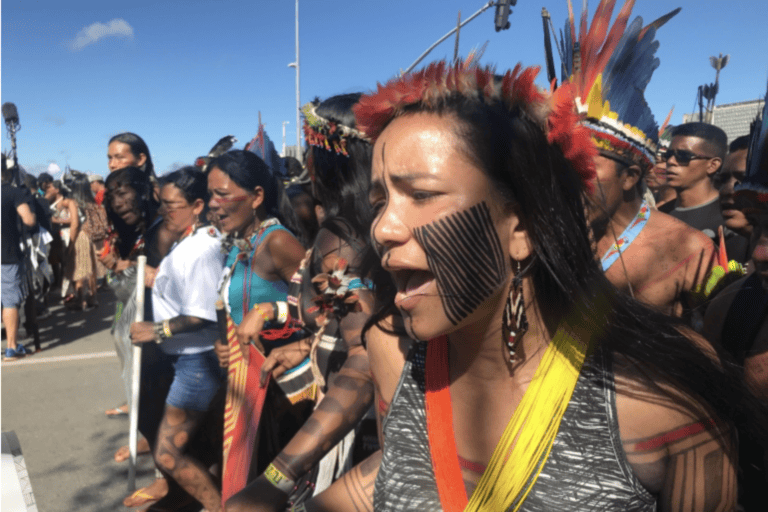- Indigenous women are important conservation leaders in the Amazon, and also recently played key roles in mobilizing responses to the COVID-19 pandemic’s effects on isolated Indigenous communities.
- Mongabay’s special reporting project, “Amazon Women,” shares their victories, visions, and struggles via a wide-ranging series of reports, interviews, videos and podcasts.
- Here are some highlights from among the dozen-plus features of these inspiring women from across the Amazon Basin.
In late 2019, Mongabay launched a special reporting project on Amazon women that took readers to communities throughout the region to meet and learn about the women who are emerging as conservation leaders. The series — in-depth articles translated into multiple languages, as well as podcasts and short-form videos — has explored everything from the importance of cultural traditions and insightful profiles of individuals, to case studies of women-led nature-based conservation strategies, and innovative research spearheaded by female scientists.
Despite the challenges experienced in 2020 associated with the coronavirus pandemic, this project surfaced during a time of massive gains for women Indigenous leaders in the Amazon. Collaboration between Mongabay’s global and Latin America news bureaus, coupled with our contributor network throughout the region allowed Mongabay to produce reports about a variety of women-led, community-based conservation models, such as native seed collection and tree planting, the formation of grassroots organizations crucial to public health, and economic stability improvements following a large oil spill in 2014.
In August 2020, Mongabay reporters spoke with the Guajajara “women warriors” of the Brazilian Amazon (guerreiras da floresta), a group of 32 Indigenous women employing 500 years of experience along with satellite technology, cameras and drones to patrol and protect the Caru Indigenous Reserve. This resulted in a decrease of deforestation in the reserve, from 2,000 hectares (4,940 acres) in 2016, to only 63 hectares (155 acres) in 2018. This story also had a dedicated podcast episode and a short-form video. Listen to the podcast here:

Mongabay contributor Claudia Geib interviewed the women involved in a co-management system that engages fishing communities in setting the harvest quota for a large fish known as pirarucu or arapaima along Brazil’s waterways. High demand for the fish led to a ban on arapaima fishing in the 1990s, but a 2020 study argued that the management system introduced in the early 2000s by the Brazilian environmental agency is helping fish populations recover and is providing opportunities for women to achieve financial independence.
Another part of the series resulted in a podcast episode featuring Osprey Orielle Lake, founder and executive director of the Women’s Earth and Climate Action Network, in which the Escazú Agreement was discussed, and the guest also spotlighted influential women leaders whom she has collaborated with in the past. You can listen to the podcast episode here:

TIME’s list of 100 most influential people in 2020 included Nemonte Nenquimo of the Waorani community, the only female Indigenous leader on this important annual list, and only the second Ecuadoran to ever be named on the list. Mongabay contributor Kimberly Brown covered the Waorani and Nenquimo’s historic victory over the Ecuadoran government which a court ruled had fraudulently gained consent from the Waorani for their territory to be auctioned off for oil exploration. This case was also summarized in a short video on YouTube.
Also in the Ecuadoran Amazon, a Mongabay reporter spoke with Noemí Gualinga, a leader of the Indigenous Kichwa Sarayaku. Known as the “mother of the jungle,” Noemí provided food and even a brigade of doctors to people stranded in Sarayaku during the dual crisis of COVID-19 and an intense 100-year flood from the overflow of the Bobonaza and Arajuno rivers. This was a time when many Indigenous communities in the six Ecuadoran provinces in the Amazon prohibited exit or entry: her commute sometimes took more than three hours.
Profiled in the Colombian Amazon was María Clemencia Herrera of the Uitoto, who founded the School of Political Education. Refusing to forget her native tongue while attending the Santa Teresita del Niño Jesús boarding school in La Chorrera, Clemencia encouraged her classmates to remember their culture. Now at age 52, she has used this experience to emphasize students’ roots, provide them with tools to defend their territory, and embrace their mission to protect Mother Earth.

Also in the Uitoto community, reporter Carol Sanchez interviewed Nazareth Cabrera, who, along with six other women in the community, stood up to the governor of the Andoque de Aduche reservation where they live, after when his son attempted to convince Indigenous spiritual guides to sign a document requesting the National Mining Agency to declare 99% of their land a mining zone. Along with the Organization of Indigenous Peoples of the Colombian Amazon (OPIAC), she and the six other women filed legal action at the Constitutional Court, which sided with Cabrera and the six Uitoto women.
In direct relation to mining and its deleterious effects, contributor Nicolás Bustamante Hernández wrote about affected communities and a study conducted by the International Pollutant Elimination Network (IPEN) and the Biodiversity Research Institute (BRI) that analyzed mercury levels in 163 women of childbearing age. The study uncovered high levels of mercury among Bolivian women who consumed fish from rivers near gold mines.
And in Peru, Gloria Alvitres profiled the first Indigenous woman to serve in a leadership role in the Indigenous federation of the Peruvian Amazon, Marisol García Apagüeño, a Kichwa leader. She is responsible for representing 14 communities that she protects from illegal logging and drug trafficking.
Mongabay is dedicated to tracking and reporting such stories of women and gender in the conservation sector to further highlight success stories where individuals have overcome social, cultural and economic barriers, and to offer examples of nature-based solutions led by women. Find all the articles on this issue under the Amazon Women topic tag.
Mike DiGirolamo is Mongabay’s audience engagement associate. Find him on Twitter @MikeDiGirolamo, Instagram or TikTok via @midigirolamo.
